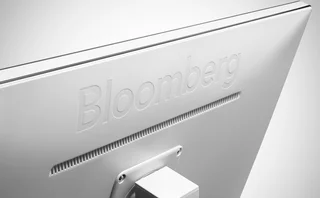
How Covid-19 exposed the fragility of FX options liquidity
Simon Nursey at Digital Vega digs into the data to reveal the lessons of the March shock

The price action that was seen in foreign exchange markets in March is a useful reminder that liquidity is a most unreliable partner, and teaches us to plan for bad times as well as good.
In February, we were looking at record low levels of volatility in a deep and liquid options market. Apparently impervious to geopolitical events and risk, many wondered if we were observing the final death of volatility. Then, in the space of a month, FX volatility rallied five times higher before dropping back down to single digits (see figure 1). What happened?
FX volatility has been in a long period of decline. Low interest rates have driven demand for yield-generating products such as FX structured products hedged by selling options, while volatility strategy funds have grown in power. At the same time, traditional option buyers have been in short supply, due to a lack of macro themes and reduced corporate hedging.
The Covid-19 pandemic became a trigger for a massive unwind of positions as equities plummeted, investors scrambled for cash and faced margin calls.
The shift to working from home and business contingency sites also limited capacity for many market-makers. What was previously a theoretical exercise suddenly became very real as some traders struggled to access all their platforms and the market from laptops and 16-inch screens.
The combined impact saw average price provider spreads increase by a factor of up to 10, but with a large dispersion between participants. On average, the widest spread in each request for quote was three times wider than the tightest. Uncertainty also meant considerable variation in prices between providers (see figure 2).
Throughout this whole period, the spread compression achieved from aggregating five providers has remained very steady at 50%, suggesting that spreads track price uncertainty very closely.
This broad variation in reactions during March extended to our price provider rankings, where relatively stable standings were up-ended as market-makers either retreated to repair positions or took advantage of active flows. Rankings have been relatively slow to stabilise compared to other aspects of the market (see figure 3).
Customers with a broad panel of providers and an active rotation strategy fared best during this busy period.
To better understand the price dynamic, we can look at our platform flow information. It’s interesting that while there is a definite pickup in buying activity from the middle of March, selling activity in general remained strong. This partly explains the very surprising speed at which vols recovered. AUD/USD was one of the few exceptions where selling activity didn’t resume until May.
So, was the volatility move a reasonable reaction to an unprecedented event? Or was it the result of a one-way market unable to cope with the double hit of market panic and disrupted trading desks?
Although a similar reaction function was repeated throughout various markets, we believe Covid-19 exposed underlying weaknesses in an FX options market that remains highly fragmented and dependent on voice channels and manual processes.
Traders should look at the manual workflows which have proven to be a liability during work-from-home. Digitisation is ultimately the best protection for any business from any future Covid-19 type liquidity events.
And buy-side users looking to prepare for the next liquidity event should consider broadening and diversifying their panel of market-makers, and employing an active rotation policy to ensure relationships are current and spreads regularly reviewed.
Simon Nursey is head of Asia-Pacific at Digital Vega, and previously an FX options trading head at Standard Chartered and BNP Paribas.
Digital Vega is a multi-bank aggregator with a customer base covering asset managers, hedge funds, private banks and regional banks, with liquidity provided by 19 major FX banks.
Only users who have a paid subscription or are part of a corporate subscription are able to print or copy content.
To access these options, along with all other subscription benefits, please contact customer services - www.fx-markets.com/static/contact-us, or view our subscription options here: https://subscriptions.fx-markets.com/subscribe
You are currently unable to print this content. Please contact customer services - www.fx-markets.com/static/contact-us to find out more.
You are currently unable to copy this content. Please contact info@fx-markets.com to find out more.
Copyright Infopro Digital Limited. All rights reserved.
You may share this content using our article tools. Printing this content is for the sole use of the Authorised User (named subscriber), as outlined in our terms and conditions - https://www.infopro-insight.com/terms-conditions/insight-subscriptions/
If you would like to purchase additional rights please email info@fx-markets.com
Copyright Infopro Digital Limited. All rights reserved.
You may share this content using our article tools. Copying this content is for the sole use of the Authorised User (named subscriber), as outlined in our terms and conditions - https://www.infopro-insight.com/terms-conditions/insight-subscriptions/
If you would like to purchase additional rights please email info@fx-markets.com
More on Tech and data
Outlook for e-FX: opportunities and risks for banks
As electronification spreads into new areas of FX trading, banks are under pressure to digitise more of their offerings to remain competitive. The race is now on to automate pricing, trading and hedging in areas such as non-deliverable forwards, swaps…
Why last look needs a new look
Insufficient LP disclosures leave fund managers in the dark on pre-trade costs, says BidFX’s data head
Measuring expected cost models on large FX trades
BestX study assesses factors influencing algo performance on trades over $100m in size
Bloomberg deploys new chatbot tool to Terminal
Offering allows users to surface data and notifications from internal systems without leaving Instant Bloomberg chatrooms
FXPBs see compression tech as key for credit optimisation
FX Markets USA: Providers hope new tech solutions can help replenish credit lines to hedge funds
JP Morgan pulls plug on deep learning model for FX algos
FX Markets USA: Bank turns to less complex models that are easier to explain to clients
US insurers take different paths to hedge FX
Counterparty Radar: Maturity and size of FX forwards trades vary significantly between firms
Corporates’ tech stacks face pressure from rising FX volatility
Treasurers and CFOs are worried about how their FX tech will cope with a potential increase in hedging activity







